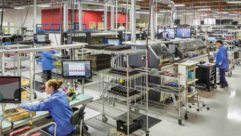
Picture This: Consumer Electronics Show 2009
Feb 1, 2009 12:00 PM,
By Jeff Sauer
Size, power usage, and attendance all decrease during tough economic times.

Microvision showed a working prototype of a laser-based pico projector. The Show WX has native WVGA resolution. Although there were no immediate plans for a retail model, the technology could be licensed for integration into a number of portable devices.
Even before the Consumer Electronics Show (CES) started, it was clear that the economy would have an effect on the event. High-profile manufactures had reduced booth displays, planned less elaborate productions, and even given up floor space altogether in favor of more modest, invitation-only hotel suites. Las Vegas hotels, usually profiteering during what is the largest tradeshow of the year, were cutting prices. Attendance was expected to be down by at least 10 percent, and preliminary estimates suggested a decline of more than 20 percent.
On the floor, that translated into less extravagance — probably a good thing — and fewer groundbreaking product announcements — admittedly less fun. Still, CES continues to offer a glimpse of the future, and while some of the product trends from this year’s show are little more than curiosities in the short term, others could have a direct effect on the AV industry.
Cell-phone-sized pico projectors, a couple of which showed up last year as technology demonstrations, were on the floor this year as shipping products. 3M’s LCoS-based cell-phone-sized pico light engine from last year was this year’s MPro110, a 5.6oz. device selling for $299. With 9 ANSI lumens and inputs for both VGA and RCA video, the MPro110 targets users of video iPods and netbook computers. Optoma’s Pico PK-101 is DLP-based and available for $399. It’s about as bright as the 3M, but it is smaller at 4oz. and 0.59in. tall. However, with only the RCA video input (no VGA in) and a native half-VGA resolution, it’s more of an iPod accessory than a presentation tool. LG Electronics showed a prototype of a similar DLP-based model, but the company didn’t offer a price or a ship date. All of the LCoS and DLP models are LED-lit.
Microvision, on the other hand, showed a working prototype of a laser-based pico. The Show WX was about the same size as the Optoma, weighed 4.3oz., had a similar profile and brightness, and could input both VGA and composite video. What set it apart, in addition to the native WVGA resolution, were very strong colors and easily the best image quality of the bunch. The Show WX isn’t for sale yet — $500 was tossed out as a number — and it’s not clear if Microvision is thinking direct retail. Licensing the technology for integration into other devices such as cell phones, cameras, netbooks, and camcorders might be a more viable strategy. Indeed, no 10-lumen projector will have much effect on professional AV, but integrated projection could if it means broader consumer appreciation for projection in general.
A few fuller-size projector companies were at CES — Epson, Optoma, and Mitsubishi, among others. Although most displayed products that were at CEDIA Expo last fall. Optoma did introduce a couple of new 2.4lb. business projectors and the next generation of two home-theater lines: the HD808 and HD8200 with built-in ISF calibration and motion estimation and compensation. In an off-the-floor suite, projectiondesign showed an upgraded version of the avielo line that debuted at CEDIA, but the new version has a new lamp modulation control and a remarkable image that belied its single-chip DLP configuration.
The biggest projection surprise was from Vivitek: the LED-lit, full 1080p, 800-lumen H6080FD. Red, green, and blue LEDs allow Vivitek to jettison the color wheel — and thus any rainbow effect — and produce both the high contrast of DLP as well as great color. Much like the LED-lit prototypes at CEDIA, this won’t be available until midyear. Vivitek also showed the dual-color-wheel D5500. See my review of the D5500 on p. 40.
Another future technology that again played a high-profile, if even more vaporous, role this year was OLED. Sony, Samsung, and LG were showing gorgeous OLED displays, but there were few additions to last year’s 11in. to 31in. sizes. LG’s new 15in. AMOLED prototype was the lone exception. Sony’s 11in. XEL-1 remains the only one that’s available for purchase, and it still commands a premium at $2,500. The major OLED announcement was Sony’s new flexible OLED, a 2.5in. screen with a resolution of 160×120 that is able to display a moving image on a thin, pliable plastic film. While this technology should only enhance OLED’s traction in cell phones and watches, larger displays still appear to be in the distant future.
Picture This: Consumer Electronics Show 2009
Feb 1, 2009 12:00 PM,
By Jeff Sauer
Size, power usage, and attendance all decrease during tough economic times.
FLATTER, GREENER, CONNECTED FLATPANELS
is year continued last year’s trends. Thin flatpanels were even more prevalentMost of the flatpanel news th across product lines, but they did not receive quite the fanfare. Some of the highlights were Samsung’s 1.1in.-thick, 50in. prototype plasma and a 0.25in.-thick LCD, as well as a Panasonic 0.33in.-thick PDP prototype. However, several companies now ship panels thinner than 2in.
Are green panels sexier than thin flatpanels? Maybe so if you have a large display infrastructure and you’re saving 30 percent to 40 percent on a major electricity bill. Even better, more efficient panels are hitting the market now from several manufacturers. Many — including Panasonic, Hitachi, and LG — had booth displays comparing wattage usage in realtime between this year’s panels and those from just a couple of years ago. What’s more, the flatpanel display industry, almost as a whole, expressed an even greater commitment to eliminating hazardous materials from within flatpanels, as well as dramatically reducing landfill waste through a variety of reclamation and disposal programs.
Connected displays picked up a little steam, and all the major manufacturers have partnered with content providers such as Yahoo (TV Widgets), The Weather Channel, and others to allow viewers to browse online content directly from the TV. So far, those offerings are fairly limited and represent a minimal subset of the Web. That makes it feel a lot like the mid-1990s, when companies such as AOL were trying to package web content for subscribers. In this case, it’s all about avoiding a keyboard or mouse, so content needs to be navigable with just a TV’s handheld remote. As in that ill-fated AOL model, that means consumers aren’t getting the whole Web. Still, accessing web content on the display directly certainly makes sense as web content proliferates.
Several makers were, as last year, talking wireless displays, although this year companies seemed to be favoring the WirelessHD technology. While several claim that they’ll be ready to ship this year, that’s been the case for two years. The only technology on sale as of CES was TZero’s Ultra Wideband, which is sold as Gefen’s Wireless HDMI Extender.
Is 3D ready for serious entertainment? Several companies think so, but none were talking about delivery dates. LG, having previously shown 3D-capable digital signage, offered a prototype LCoS-based 3D projector. Panasonic devoted a section of its booth to a future living room and its new 3D FHD system, which included a 3D-capable plasma display and Blu-ray player showing custom 3D content from Panasonic Hollywood Labs. Sony, in addition to an in-booth 3D demo for its PlayStation 3, rented an entire theater for a live 3D broadcast of the NCAA National Championship football game. It looked great when the action was limited, but fast pans were awkward at best. Still, 3D continues to be billed as the next big thing in displays. Stay tuned.








